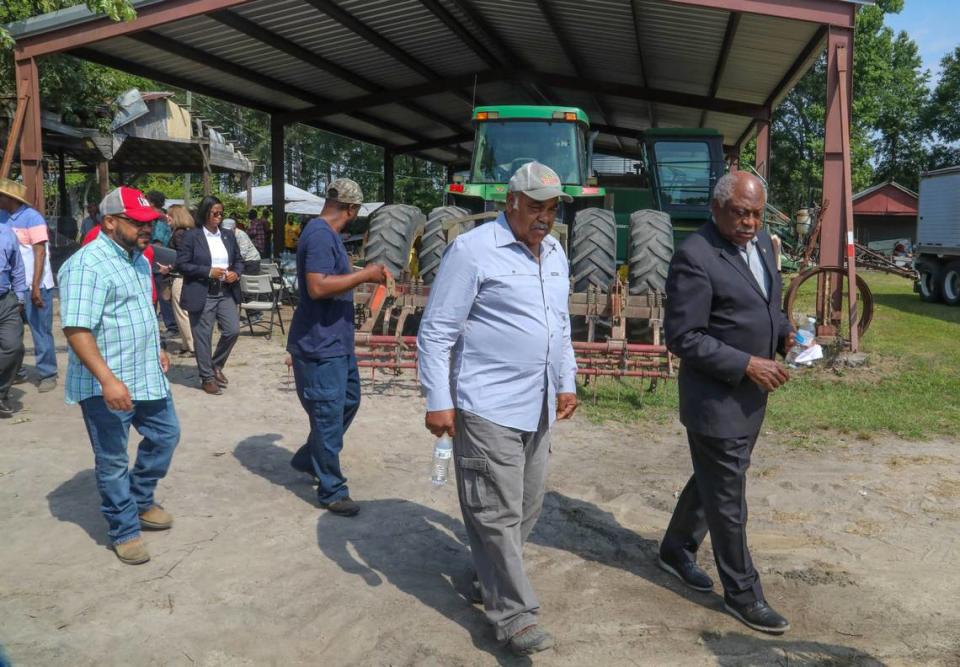Disadvantaged SC farmers can get debt relief in COVID-aid package. Here’s who qualifies
Outside on his farm of more than 300 acres, where he and his family grow corn, soybeans, oats, barley, cotton and wheat, 69-year-old Nathaniel Rhodes reminisced of how Black farmers like himself had trouble getting loans to run their operations.
He said minorities would see higher interest rates than they’re white counterparts.
“We always ... paid more or we will be turned down when our credit was better, or just as good ... (because) of the color of skin,” Rhodes said.
And after a year where farmers saw less demand for their crops because of the economic slowdown caused by the COVID-19 pandemic, Rhodes and his family, as well as other minority farmers, are set to receive some targeted relief.
Alongside Rhodes, House Majority Whip Jim Clyburn, D-Columbia, and U.S. Agriculture Secretary Tom Vilsack promoted a USDA loan forgiveness program for disadvantaged farmers, which was included as part of the American Rescue Plan Act, the Biden administration’s COVID relief package that became law in March.
Farmers who are Black, American Indian, Alaskan natives, Hispanic, Asian American, or Pacific Islander are eligible to have the USDA pay off 120% of loans the farmers were issued or guaranteed by the USDA.
“It’s very targeted, it’s very specific and it addresses the disparity between white farmers who received a tremendous amount of money during the COVID relief situation and socially disadvantaged producers who received relatively very little,” Vilsack said.
The USDA expects the program to pay off 15,000 to 18,000 loans worth up to $4 billion, Vilsack said.
The Trump administration had $26 billion for farmers in COVID relief legislation. However, Vilsack said almost all of it went to white farmers.
Black farmers make up 1.3% of the 3.4 million farmers in the country, according to the USDA. Black farmers only received 0.1% of COVID to farmers, Vilsack told the Washington Post.
In 2017, more than 35,800 of the South Carolina’s 38,970 farmers, were white.
In 2017, more than 35,800 of South Carolina’s 38,970 farmers, were white, while 2,570 S.C. farmers were black, according to the USDA.
“This is to right a wrong,” Clyburn said. “I learned from my history that the greatness of this country is not that we are more enlightened in this nation, but because we’ve always been able to repair our faults.”
Vilsack said banks will receive prepayment penalties to reimburse them for losses with loans being paid off early, and banks will be able to lend money again possibility at a higher interest rate.
“When you pay off all the loans, you eliminate any risk to the bank,” Vilsack said.
The program will pay off farm ownership loans, operating loans, conservation loans, storage facility loans, microloans and youth loans, emergency loans, conservation loans, and soil and water loans.
Although Rhodes himself doesn’t have any farming debt, the program will help his children and grandchildren continue the family business.
“This loan would help me for some of the things that I already spent my personal money on and things I could like to do on the farm in the future to help my children to grow,” Rhodes said.
His 16-year-old grandson Eric Jones has a youth loan. He’s in his third year of taking out a $5,000 loan, something Jones has been able to pay back the first two years.
But being eligible for this USDA program this year gives Jones a head start for next year, when having available cash is key for keeping a farm business going. Prices for crops fluctuate, but the price of inputs such as equipment, pesticides, seeds and taxes all increase.
“That’s more money in my pocket for seeds, fertilizer, and a little bit more stuff for next year,” Jones said.
For information on how to apply go to www.farmers.gov/americanrescueplan.



